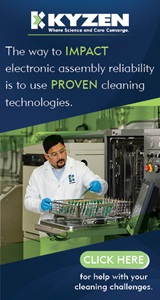|

|
|
| Ask the Experts | |||||||
|
|||||||
|
December 8, 2008 - Updated December 1, 2008 - Originally Posted Conformal Coating Around Press Fit ConnectorsWhat type of conformal coating should be used on circuitn boards with press fit connectors? Will wicking be reduced if fast curing UV coating is used? E. K. |
|||||||
| Expert Panel Responses | |||||||
|
From what I understand, a "press fit" connector should push through most types of standard conformal coating. The best way to ensure complete coverage is to conformally coat the PCB prior to attaching the connectors. The connectors can then be attached, with the pins forcing their way through the conformal coating that will have cured over the designated holes. This will ensure that the coating covers up to the pins of the connectors. The coating will need to have very good adhesion to the PCB and must not be too brittle, otherwise the coating may "flake" off the board when the connectors are attached. This would obviously need to be trialled in your application. An acrylic coating such as Electrolube APL would be a good starting point for the trials. If you are concerned with this method of application you could try masking the area where the "press fit" connectors are to be attached. Once coated the masking can be removed and the connectors attached. To ensure full protection I would then advise sealing around the base of the connector by either brushing a thin layer of the coating or using a thixotropic version of the coating. Electrolube produce a coating called DCA and a thixotropic version of the coating DCE, although a number of coatings could be trialled. A masking product such as PCM or PCS could be used alongside these coatings if this method of application is preferred. I think the best thing would be to establish what level of protection you require from the coating first and then select a suitable coating. You can then try one of the application methods described above to establish the highest level of protection achievable. Regarding your question on "wicking", I am not completely sure what the problem is here as the term "wicking" can be used in various ways. If you are referring to stopping the coating from flowing into various areas then I would advise a selective coating application or the use of a masking agent. UV coatings will cure very quickly when exposed to UV light however any shadowed areas will take longer to cure, therefore material under components may still be fluid. Again, this will be dependent on your application. If you could explain your application in more detail then I may be able to help with this query further.
European Technical Support Specialist Electrolube Ltd Jade Bridges is the European Technical Support Specialist for Electrolube. She is responsible for technical support within Europe, offering assistance to customers with product selection, implementation and after sales support across the range of Electrolube products. Her expertise is carried over from her position as R&D Manager for Electrolube, where she was responsible for the new product development and technical support across an array of chemical products for the electronics industry, including conformal coatings, encapsulation resins, thermal management products, contact lubrication and electronic cleaning solutions.
As I understand the What type of conformal coating should be used if the board has "press fit" connectors?' question, the customer is asking about a desire to push fit the connectors through a conformal coating. In this case, I would say that the key is to choose a soft coating to enable ease of push-fit and avoid risk of damaging the connector. Acrylic materials are generally used by most people doing this kind of assembly, although some softer urethane coatings can work with a bit more effort, especially if the connector is fitted as soon as the material is touch dry. UV cure materials, are generally pretty tough after UV curing and so are less suitable (in general) for this kind of assembly.
Global Business Director conformal coatings division Electrolube Phil Kinner - Electrolube - Global Business Director conformal coatings division.
Wicking will be the result of the surface tension and material viscosity. To prevent the capillarity action you need to have a higher viscosity material. Cure speed maybe a factor as well: however UV won't work unless the material actually wicks enough to go thru the connector to be cured once it reaches the other side, which is what he is trying to prevent. Hope this helps.
Sales Manager Krayden, Inc. Gary Bowman has been in distribution sales for 33 years selling into Electronic, Aerospace, Medical and OEM market place. Bowman has been with Krayden for 18 years.
|
|||||||
| Submit A Comment | |||||||
|
Comments are reviewed prior to posting. You must include your full name to have your comments posted. We will not post your email address. |
|
Free Newsletter Subscription
Circuitnet is built for professionals who bear the responsibility of looking ahead, imagining the future, and preparing for it. Insert Your Email Address |
|

|





